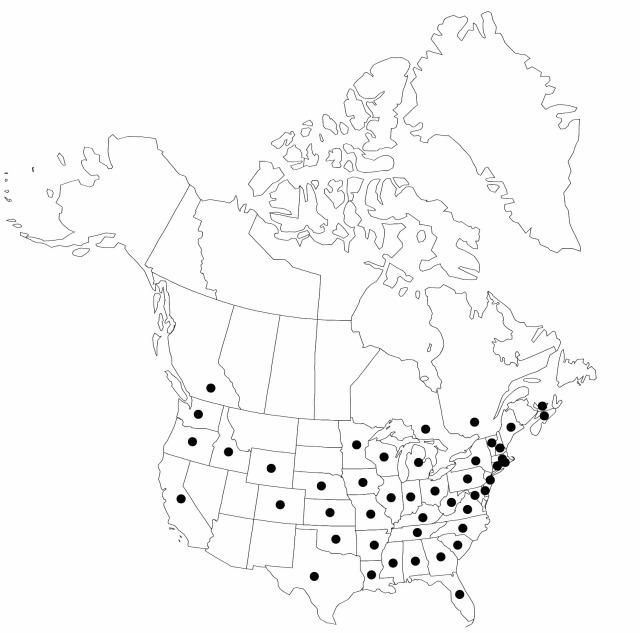Difference between revisions of "Eleocharis obtusa"
Mant. 2: 89. 1824.
FNA>Volume Importer |
FNA>Volume Importer |
||
| Line 11: | Line 11: | ||
|name=Scirpus obtusus | |name=Scirpus obtusus | ||
|authority=Willdenow | |authority=Willdenow | ||
| + | |rank=species | ||
|publication_title=Enum. Pl. | |publication_title=Enum. Pl. | ||
|publication_place=1: 76. 1809 | |publication_place=1: 76. 1809 | ||
| Line 17: | Line 18: | ||
|name=Eleocharis obtusa var. ellipsoidales | |name=Eleocharis obtusa var. ellipsoidales | ||
|authority=Fernald | |authority=Fernald | ||
| + | |rank=variety | ||
}} {{Treatment/ID/Synonym | }} {{Treatment/ID/Synonym | ||
|name=Eleocharis obtusa var. gigantea | |name=Eleocharis obtusa var. gigantea | ||
|authority=Fernald | |authority=Fernald | ||
| + | |rank=variety | ||
}} {{Treatment/ID/Synonym | }} {{Treatment/ID/Synonym | ||
|name=Eleocharis obtusa var. jejuna | |name=Eleocharis obtusa var. jejuna | ||
|authority=Fernald | |authority=Fernald | ||
| + | |rank=variety | ||
}} {{Treatment/ID/Synonym | }} {{Treatment/ID/Synonym | ||
|name=Eleocharis obtusa var. peasei | |name=Eleocharis obtusa var. peasei | ||
|authority=Svenson | |authority=Svenson | ||
| + | |rank=variety | ||
}} | }} | ||
|hierarchy=Cyperaceae;Eleocharis;Eleocharis subg. Eleocharis;Eleocharis sect. Eleogenus;Eleocharis (sect. Eleogenus) ser. Ovatae;Eleocharis obtusa | |hierarchy=Cyperaceae;Eleocharis;Eleocharis subg. Eleocharis;Eleocharis sect. Eleogenus;Eleocharis (sect. Eleogenus) ser. Ovatae;Eleocharis obtusa | ||
| Line 41: | Line 46: | ||
|elevation=10–1600 m | |elevation=10–1600 m | ||
|distribution=B.C.;N.S.;Ont.;P.E.I.;Que.;Ala.;Ark.;Calif.;Colo.;Conn.;Del.;D.C.;Fla.;Ga.;Idaho;Ill.;Ind.;Iowa;Kans.;Ky.;La.;Maine;Mass.;Mich.;Minn.;Miss.;Mo.;Nebr.;N.H.;N.J.;N.Y.;N.C.;Ohio;Okla.;Oreg.;Pa.;R.I.;S.C.;Tenn.;Tex.;Vt.;Va.;Wash.;W.Va.;Wis.;Wyo.;Pacific Islands (Hawaii). | |distribution=B.C.;N.S.;Ont.;P.E.I.;Que.;Ala.;Ark.;Calif.;Colo.;Conn.;Del.;D.C.;Fla.;Ga.;Idaho;Ill.;Ind.;Iowa;Kans.;Ky.;La.;Maine;Mass.;Mich.;Minn.;Miss.;Mo.;Nebr.;N.H.;N.J.;N.Y.;N.C.;Ohio;Okla.;Oreg.;Pa.;R.I.;S.C.;Tenn.;Tex.;Vt.;Va.;Wash.;W.Va.;Wis.;Wyo.;Pacific Islands (Hawaii). | ||
| − | |discussion=<p>Extremely uncommon plants of <i>Eleocharis obtusa</i> without perianth bristles may be called <i>E. obtusa</i> var. peasei (type from New Hampshire). Robust plants with distinct caudices, floral scales 2.5 mm, and achenes 1.2–1.3 mm (<i>Eleocharis obtusa</i> < | + | |discussion=<p>Extremely uncommon plants of <i>Eleocharis obtusa</i> without perianth bristles may be called <i>E. obtusa</i> var. peasei (type from New Hampshire). Robust plants with distinct caudices, floral scales 2.5 mm, and achenes 1.2–1.3 mm (<i>Eleocharis obtusa</i> <i></i>var.<i> gigantea</i> Fernald) are rare (specimens seen from the Washington-British Columbia border [type], Arkansas, and the Hawaiian Islands). Dwarf plants (<i>E. obtusa</i> var. jejuna Fernald, type from Maine), with unusually small achenes and floral scales, and tubercles often less than 0.5 mm wide, are occasional in the East and are easily confused with <i>E. ovata</i> and <i>E. aestuum</i>. A few specimens are intermediate with <i>E. engelmannii</i>. <i>Eleocharis obtusa</i> is sometimes treated as conspecific with <i>E. ovata</i>, which consistently differs in its mostly 2-fid styles, mostly two stamens, and especially its narrower tubercles (B. M. H. Larson and P. M. Catling 1996).</p><!-- |
--><p><i>Eleocharis</i> macounii Fernald has been treated as a synonym of E. obutsa (H. K. Svenson 1957) but is more probably a hybrid between <i>E. intermedia</i> and <i>E. obtusa</i> (P. M. Catling and S. G. Hay 1993; see 34. <i>E. intermedia</i>).</p> | --><p><i>Eleocharis</i> macounii Fernald has been treated as a synonym of E. obutsa (H. K. Svenson 1957) but is more probably a hybrid between <i>E. intermedia</i> and <i>E. obtusa</i> (P. M. Catling and S. G. Hay 1993; see 34. <i>E. intermedia</i>).</p> | ||
|tables= | |tables= | ||
| Line 51: | Line 56: | ||
-->{{#Taxon: | -->{{#Taxon: | ||
name=Eleocharis obtusa | name=Eleocharis obtusa | ||
| − | |||
|authority=(Willdenow) Schultes | |authority=(Willdenow) Schultes | ||
|rank=species | |rank=species | ||
| Line 66: | Line 70: | ||
|publication year=1824 | |publication year=1824 | ||
|special status= | |special status= | ||
| − | |source xml=https://jpend@bitbucket.org/aafc-mbb/fna-data-curation.git/src/ | + | |source xml=https://jpend@bitbucket.org/aafc-mbb/fna-data-curation.git/src/f50eec43f223ca0e34566be0b046453a0960e173/coarse_grained_fna_xml/V23/V23_159.xml |
|genus=Eleocharis | |genus=Eleocharis | ||
|subgenus=Eleocharis subg. Eleocharis | |subgenus=Eleocharis subg. Eleocharis | ||
Revision as of 20:05, 16 December 2019
Culms 3–50(–90) cm × 0.2–2 mm. Leaves: apex of distal leaf sheath obtuse to acute, tooth to 0.3 mm. Spikelets broadly ovoid (to ellipsoid or lanceoloid), apex rounded (to acute), (2–)5–13 × (2–)3–4 mm; floral scales 15–150+, 8–20 per mm of rachilla, orange-brown (to stramineous), elliptic, 1.5–2.5 × 1–1.5 mm, midribs seldom keeled, apex broadly rounded. Flowers: perianth bristles (5–)6–7, rarely 0, brown, stout, slightly to usually greatly exceeding tubercle; stamens usually 3; anthers brown to yellow, 0.3–0.6 mm; styles usually 3-fid and 2-fid in same spikelet. Achenes 0.9–1.2(–1.3) × 0.7–0.9 mm. Tubercles deltoid 0.35–0.5 × (0.4–)0.5–0.8 mm, 1/3–2/3 as high as wide, 1/3–1/2 as high and 2/3–9/10 as wide as achene. 2n = 10.
Phenology: Fruiting summer–fall.
Habitat: Fresh shores, marshes, disturbed places
Elevation: 10–1600 m
Distribution

B.C., N.S., Ont., P.E.I., Que., Ala., Ark., Calif., Colo., Conn., Del., D.C., Fla., Ga., Idaho, Ill., Ind., Iowa, Kans., Ky., La., Maine, Mass., Mich., Minn., Miss., Mo., Nebr., N.H., N.J., N.Y., N.C., Ohio, Okla., Oreg., Pa., R.I., S.C., Tenn., Tex., Vt., Va., Wash., W.Va., Wis., Wyo., Pacific Islands (Hawaii).
Discussion
Extremely uncommon plants of Eleocharis obtusa without perianth bristles may be called E. obtusa var. peasei (type from New Hampshire). Robust plants with distinct caudices, floral scales 2.5 mm, and achenes 1.2–1.3 mm (Eleocharis obtusa var. gigantea Fernald) are rare (specimens seen from the Washington-British Columbia border [type], Arkansas, and the Hawaiian Islands). Dwarf plants (E. obtusa var. jejuna Fernald, type from Maine), with unusually small achenes and floral scales, and tubercles often less than 0.5 mm wide, are occasional in the East and are easily confused with E. ovata and E. aestuum. A few specimens are intermediate with E. engelmannii. Eleocharis obtusa is sometimes treated as conspecific with E. ovata, which consistently differs in its mostly 2-fid styles, mostly two stamens, and especially its narrower tubercles (B. M. H. Larson and P. M. Catling 1996).
Eleocharis macounii Fernald has been treated as a synonym of E. obutsa (H. K. Svenson 1957) but is more probably a hybrid between E. intermedia and E. obtusa (P. M. Catling and S. G. Hay 1993; see 34. E. intermedia).
Selected References
None.
